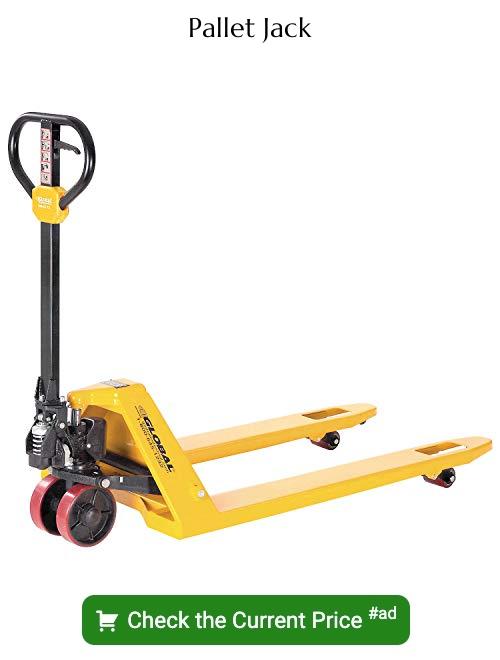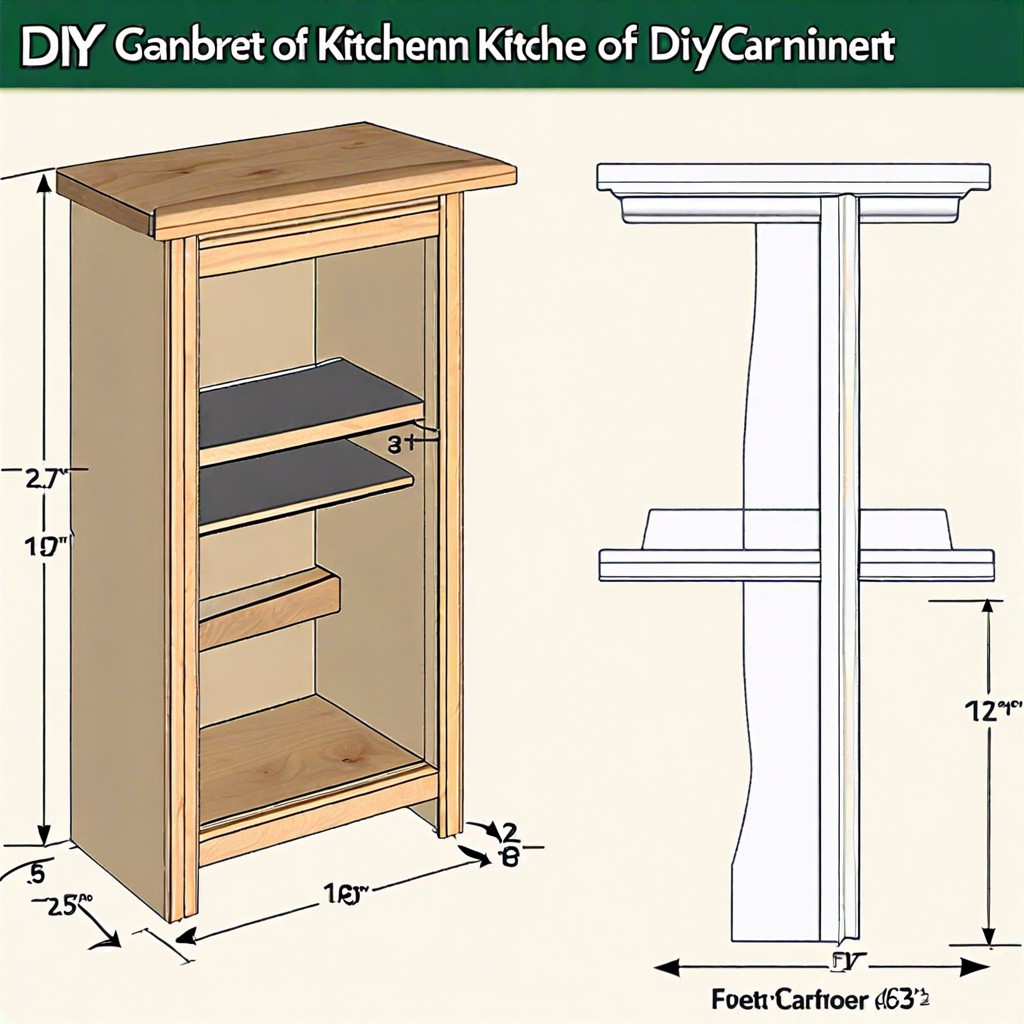Last updated on
How big is a pallet exactly? The standard size is 48″ x 40″. We venture to give you real-life examples to better understand what this size means.
Key takeaways:
- Standard pallet size: 48″ x 40″
- Height of standard pallet: 6 inches
- Load capacity affects pallet height and material
- Wooden pallets weigh 30-48 pounds
- Different regions have specific pallet sizes
What's Inside
Standard Pallet Size & Dimensions

When discussing common measurements, the most frequently encountered is the 48 inches by 40 inches—a size that’s become somewhat of a global standard, particularly in North America. The height of a standard pallet typically hovers around 6 inches, but this can vary depending on the load capacity and intended use.
Here are some quick points of interest on this topic:
- Dimensions are width by length: for a standard pallet, that’s 48″ x 40″
- Height can vary, but 6 inches is a general standard for empty pallets
- Load capacity influences height and build material; heavy-duty pallets might be taller due to structural requirements
- Pallet weight will range depending on the material, with wooden pallets averaging between 30-48 pounds
Remember, while this size is prevalent in many industries, it’s important for businesses to verify the standard suited for their specific needs and logistical channels.
North American Pallet Sizes

In North America, the most widely used pallet size is the 48” x 40” known colloquially as the GMA (Grocery Manufacturers Association) pallet. This dimension has become somewhat of a standard due to its adoption by the grocery industry and integration within the Material Handling Industry’s recommendations. It isn’t the only one, though. You’ll also encounter:
- 42” x 42”: Commonly used for telecommunication and paint industries, providing a snug fit into shipping containers with less wasted space.
- 48” x 48”: Ideal for the drums industry, this size is designed to support heavier loads and can accommodate a multiplicity of large barrels.
Pallet sizes in North America are tailored to be compatible with the ISO container dimensions, ensuring efficiency in global shipping. The width of the pallet corresponds roughly to the width of the container door, making loading and unloading processes seamless. When considering which pallet size to use, it’s crucial to think about the industry standards, load size, shipping requirements, and the storage capabilities of the receiver.
European Pallet Dimensions
When discussing European pallet sizes, the most recognizable format is the Euro pallet, also known as the EUR-pallet or EPAL pallet. This standard size is widely adopted for its compatibility with existing infrastructure and logistics systems throughout Europe and beyond:
- The Euro pallet typically measures 1200 mm by 800 mm or approximately 47.2 by 31.5 inches.
- Constructed to be sturdy, the specifications are tightly controlled by the European Pallet Association, ensuring consistency.
- Its durability and design make it suitable for heavy goods and for use in high racks.
- Known for its six-runner base, it allows entry from all four sides, making it versatile for handling and transportation.
- The standardization of the Euro pallet facilitates efficient shipping and storage, reducing costs and minimizing cargo movement during transit.
By adhering to these dimensions, businesses can streamline their shipping processes and partake in a shared exchange system, simplifying the logistics chain across different markets.
ISO Pallets Dimensions
ISO pallet dimensions are designed to fit into containers and interconnect with international handling facilities, ensuring seamless transport and storage efficiency globally. These standardized sizes allow businesses to predict and optimize the load capacity in various shipping scenarios.
- Six ISO pallet dimensions are widely recognized, the most common being 1219 x 1016mm (48″ x 40″), which aligns with the North American pallet size and is commonly used in North America.
- The second largest, 1200 x 1000mm, is frequently used in Europe and Asia and optimizes container space in export scenarios.
- For those dealing with the European standard, the 800 x 1200mm Euro-pallet fits neatly into ISO containers and is highly favored for its compatibility and reusability in European markets.
- Additionally, the 1219 x 1219mm pallet, often utilized for drum storage, fits perfectly into the 20- and 40-foot ISO containers.
- Two slightly less common sizes, the 1143 x 1143mm and 1067 x 1067mm pallets, are primarily used in Asia and North America respectively, particularly for beverage and telecommunication industries.
Choosing the correct ISO pallet dimensions can notably reduce shipping costs and material handling issues, streamlining logistics and supply chain processes across borders.
Australian Standard Pallet Dimensions
Australia follows its own set of standard dimensions for pallets, diverging from both North American and European measurements. Notably, the Australian standard pallet size is 1165mm x 1165mm (45.87 inches x 45.87 inches). These square-shaped platforms are designed to fit perfectly in the country’s railway containers and are also widely used in Australian warehouses and supply chains.
The choice for a square design maximizes the use of space in the standard Australian transportation systems, including rail and road, without overhanging pallet racks. Plus, the uniformity of size across the country assists in optimizing the handling and storage of goods, streamlining operations for both large and small businesses.
It’s important to note that when dealing with international shipping, compatibility with international pallet sizes should be considered to avoid extra costs and complications.
Types of Pallets: Plastic, Wooden, Metal
Wooden pallets are the industry’s workhorse, known for their strength and cost-effectiveness. Typically made from softwoods or recycled lumber, they are easy to repair and can support a wide range of loads.
Plastic pallets, on the other hand, offer a lightweight and durable alternative. They are ideal for export, as they don’t require fumigation, and resist moisture, insects, and fungi. Plus, their smooth design makes them easy to clean and sanitize, a bonus for the food and pharmaceutical industries.
Metal pallets, usually constructed from steel or aluminum, stand out for their remarkable longevity and capacity to carry heavy loads. While less common due to higher costs, they shine in industries where hygiene and fire resistance are paramount.
48″ X 40″ 4-way Pallet
The 48″ x 40″ 4-way pallet is a classic design pivotal to efficient logistics and storage. Its dimensions accommodate various loading and unloading methods, making it versatile for widespread industrial use.
Here’s what sets it apart:
- Accessibility: Unlike 2-way pallets, forklifts and pallet jacks can enter from all four sides, increasing maneuverability in tight spaces.
- Strength and Durability: Typically built from high-quality timber, these pallets are designed to withstand heavy loads and repeated use.
- Stackability: Their uniform size allows for straightforward stacking, optimizing space in warehouses and shipping containers.
- Harmonization: Being the most common size in the U.S., the 48″ x 40″ enhances compatibility between different companies’ operations within supply chains.
Understanding this particular pallet type is key to making informed choices for your storage and transportation needs, ensuring goods are handled safely and efficiently.
Why Are Standard Pallet Sizes Important?
Standardizing pallet sizes streamlines logistics operations across various industries and regions, enhancing efficiency in several ways. It promotes uniformity in material handling, allowing for the design of standardized equipment such as forklifts and pallet jacks that fit universally with these pallets.
As a result, loading and unloading times are reduced, and warehouse storage can be optimized, conserving space by using racking systems tailored to these dimensions. Additionally, standardized sizes simplify the calculation of shipping costs and help minimize damage to goods by ensuring a better fit within transportation vehicles.
It also facilitates international trade by aligning with global shipping regulations. Ultimately, this standardization leads to lower operational costs and improved supply chain management.
How Much Does a Pallet Weigh
Understanding the weight of a pallet is crucial for logistics, safety, and cost calculations. Different materials used for pallet construction lead to varying weights.
A standard wooden pallet typically weighs between 30 to 48 pounds. The heavier end accounts for hardwood species used in crafting durable pallets.
Plastic pallets, often lighter, can weigh between 3 to 15 pounds, providing a more lightweight option for shipping.
Metal pallets, although less common due to their weight and cost, can tip the scales at anywhere from 33 to 80 pounds, depending on size and material.
The pallet’s weight also impacts shipping costs and load management. Understanding these weights helps optimize transport efficiency and ensure compliance with weight regulations during shipping.
The History of The Standard Pallet
Tracing back to the early 20th century, pallets emerged amid the quest for efficiency in material handling. Initially, they were simple wooden platforms used for stacking goods to streamline loading and unloading processes.
The Second World War marked a pivotal moment in pallet development; the high demand for moving vast quantities of supplies necessitated the standardization of sizes to optimize cargo space in transport vehicles.
The introduction of the forklift in the 1930s was a catalyst for the pallet’s evolution. As the forklift’s popularity grew, pallets needed to be stronger and more uniform. This led to more systematic designs aimed at withstanding heavier loads and allowing for easier maneuvering by forklifts, thus transforming warehouses and storage practices globally.
In 1968, the Grocery Manufacturers of America (GMA), now known as Consumer Brands Association, played a major role by setting guidelines for a standard pallet size, effectively shaping the design of warehousing facilities and the transport industry. This move enhanced compatibility and interoperability in the material handling infrastructure, streamlining global trade.
Today’s standard pallets are the fruit of this rich history, with an eye not just on efficiency, but also on sustainability, ensuring that they are a mainstay in supply chains around the world.
FAQ
What is the size of 1 pallet?
The standard size of a pallet is 48 inches by 40 inches with each deck board measuring 3.5 inches wide by 5/16 inches thick.
What does a pallet look like?
A pallet is a wooden structure composed of three to four stringers supporting multiple deckboards, arranged in a way that goods can be placed on top, with its measurements specified by the length of the stringer first and the deckboard second.
What is pallet type size?
Pallet type sizes commonly encompass dimensions of 48×40 inches (prevalent in North America), 1200x1000mm (widely used in Europe and Asia), 45.9×45.9 inches (typical in Australia), and 42×42 inches (employed across North America, Asia, and Europe).
How do you list pallet dimensions?
To list pallet dimensions, it’s important to express them in the sequence of stringer length followed by deckboard length, such as 48×40 for GMA pallets, with non-wood pallet sizes typically listed by their longest length first.
How much weight can a standard pallet hold?
A standard pallet can typically hold between 1,000 and 4,500 lbs.
What are the different types of pallets and their dimensions?
The different types of pallets include stringer pallets, block pallets, and perimeter base pallets, coming in dimensions like 48″ x 40″ (North American Standard), 42″ x 42″ (Telecommunications), 48″ x 48″ (Drums), 40″ x 48″ (Military), and 48” x 45” (Automotive).
Are there standard pallet sizes globally, or do they vary by country?
Pallet sizes do vary by country, although the International Organization for Standardization (ISO) has identified six common sizes used globally.





